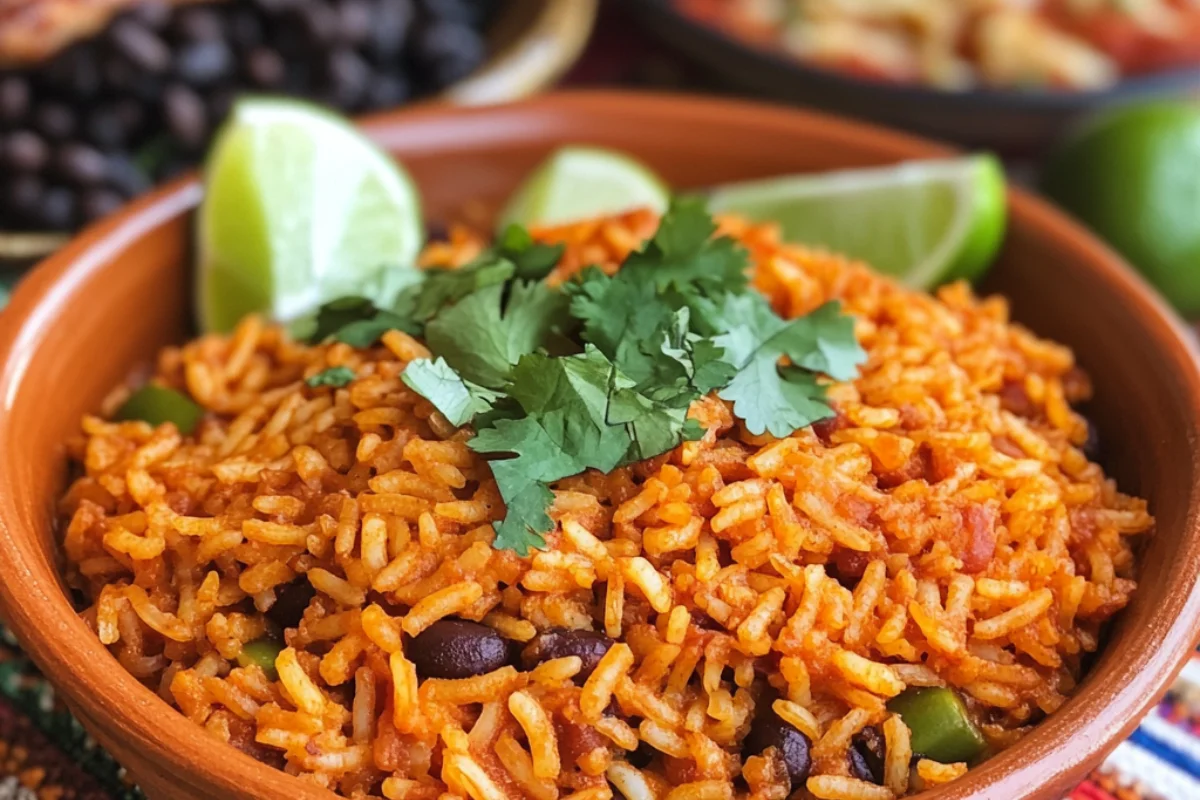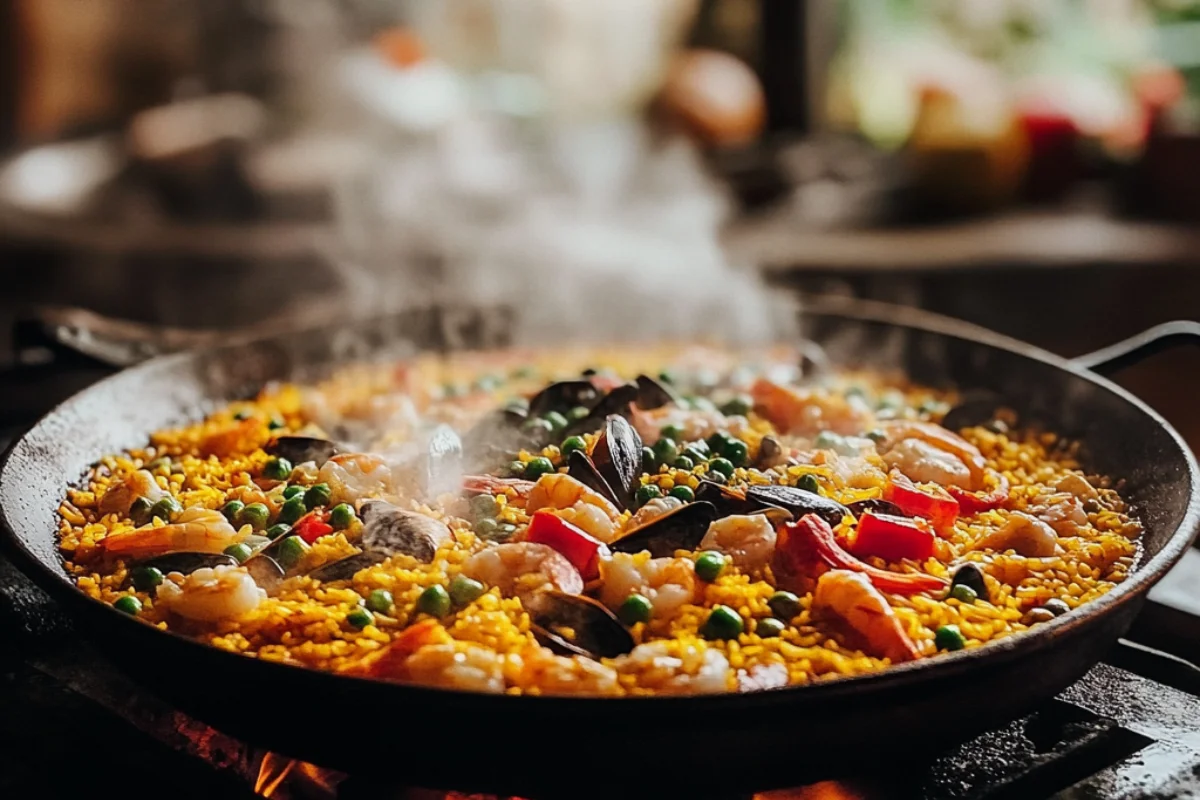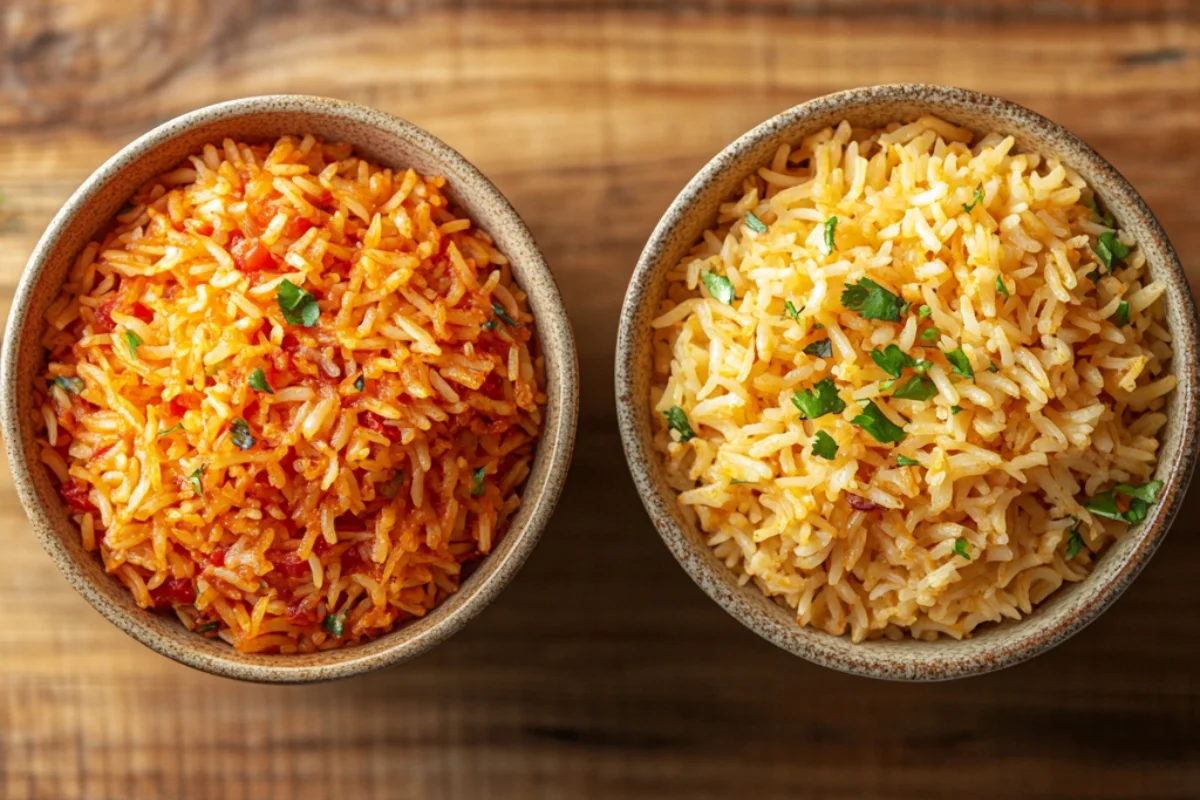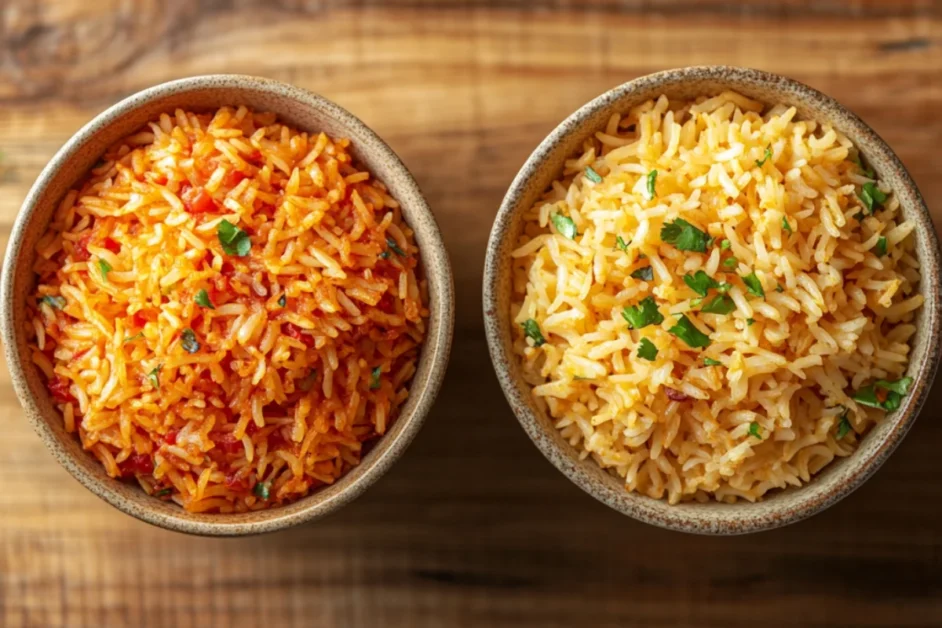Introduction to Mexican Rice vs. Spanish Rice
Rice is a staple food across various cultures, but Mexican Rice and Spanish Rice are two distinct dishes that are often confused. While both share similarities in appearance, ingredients, and cooking methods, they have unique flavors and cultural significance.
Mexican Rice, also known as arroz rojo, is a flavorful dish made with tomatoes, garlic, onions, and cumin. It is commonly served as a side dish in Mexican cuisine, complementing tacos, enchiladas, and other traditional meals. On the other hand, Spanish Rice, often associated with paella, is infused with saffron, olive oil, and seafood or meats, giving it a rich and aromatic taste.
Despite the confusion, these dishes have distinct historical origins and culinary techniques. Understanding the differences between Mexican and Spanish rice allows for a deeper appreciation of their unique flavors and cultural heritage.
Historical Background of Mexican Rice
Mexican Rice has deep roots in Mexican cuisine, dating back to the Spanish colonization of Mexico in the early 1500s. The Spaniards introduced rice to Mexico after bringing it from Asia, and the grain quickly became a staple in Mexican households.
Unlike Spanish rice, which relies heavily on saffron, Mexican rice is seasoned with tomatoes, cumin, garlic, and chicken broth, which enhance its earthy and slightly spicy flavors. Over time, different regions in Mexico developed their variations of the dish:
- In Central Mexico, rice is often cooked with peas, carrots, and bell peppers.
- In Northern Mexico, some versions include bits of chorizo or ground beef.
- In Southern Mexico, rice is frequently served alongside black beans and plantains.
This dish has become a symbol of Mexican home cooking, served with almost every meal. Whether in street food or festive occasions, Mexican rice remains a beloved part of the country’s culinary tradition.
Historical Background of Spanish Rice
Spanish Rice has a different history, deeply influenced by Moorish and Mediterranean culinary traditions. The Moors introduced rice to Spain during their rule from the 8th to the 15th century. Along with rice, they also introduced saffron, a key ingredient that gives Spanish rice its signature golden color.
The dish evolved into various forms, with the most famous being paella, a rice dish from the Valencia region. Unlike Mexican rice, which is cooked with a tomato-based broth, Spanish rice is often prepared with:
- Saffron, which gives it a rich, golden hue.
- Olive oil, a staple in Spanish cooking.
- Seafood, chicken, or rabbit, depending on the regional variation.
Over centuries, Spanish rice spread across different parts of Spain and Latin America, influencing the way rice dishes are cooked worldwide. The use of saffron, paprika, and slow-cooking techniques makes Spanish rice unique compared to its Mexican counterpart.
Why Are They Often Confused?
The confusion between Mexican Rice and Spanish Rice stems from several factors:
- Appearance – Both dishes have a reddish or golden hue, making them look somewhat similar.
- Name Confusion – In the U.S., people often use the term Spanish Rice when referring to Mexican Rice, which leads to misunderstandings.
- Interchangeable Uses – Both dishes are served as side dishes to accompany meats, seafood, or beans, making them seem interchangeable in meals.
Despite these similarities, the seasoning, cooking techniques, and cultural background of the two dishes are quite distinct.
Geographical Influence on Rice Dishes
The environment and climate of a region play a crucial role in shaping the ingredients and cooking styles of different rice dishes.
- Mexico’s Climate – The warm and arid conditions in many parts of Mexico make tomatoes, peppers, and cumin readily available. These ingredients define Mexican Rice.
- Spain’s Climate – The Mediterranean climate in Spain favors olive trees, saffron cultivation, and seafood availability, all of which contribute to the unique flavors of Spanish Rice.
Additionally, Spanish rice is typically cooked with local meats like chorizo, rabbit, or seafood, while Mexican rice is commonly served as a side dish to tacos, enchiladas, and grilled meats.
Key Ingredients in Mexican Rice
The flavor of Mexican Rice comes from a combination of simple yet essential ingredients:
- Tomatoes – Give the rice its reddish color and slightly tangy taste.
- Onions & Garlic – Enhance the depth of flavor and aroma.
- Cumin – Adds an earthy, smoky element to the dish.
- Chicken Broth – Provides a rich, savory base.
- Spices – Can include black pepper, chili powder, and bay leaves, depending on the recipe.
Some variations also include vegetables like peas, corn, and carrots to add texture and color.
Key Ingredients in Spanish Rice
Unlike Mexican Rice, Spanish Rice has a different flavor profile, influenced by Mediterranean and Moorish traditions. Its key ingredients include:
- Saffron – The most important spice, giving the rice its golden color and unique aroma.
- Olive Oil – Provides a distinct, rich base flavor.
- Seafood, Chicken, or Rabbit – Adds depth to the dish, depending on the region.
- Paprika & Garlic – Enhances the warmth and complexity of the dish.
- Bell Peppers & Peas – Frequently included for additional flavor and color.
These ingredients create the distinct taste of Spanish Rice, which is often more aromatic and complex compared to Mexican Rice.
Cooking Techniques for Mexican Rice
Cooking Mexican Rice involves several key steps:
- Toasting the Rice – Before adding liquid, the rice is toasted in oil to enhance its flavor.
- Adding Tomato Sauce & Spices – The rice is cooked with blended tomatoes, garlic, cumin, and chicken broth.
- Simmering – The mixture is simmered until the rice absorbs the liquid, creating a fluffy texture.
This method ensures that Mexican Rice remains light and flavorful while complementing other dishes.
Cooking Techniques for Spanish Rice
The process of making Spanish Rice differs significantly:
- Sautéing with Olive Oil – The rice is first sautéed with olive oil to coat each grain.
- Adding Broth & Saffron – The saffron-infused broth is gradually poured in, allowing the rice to absorb the flavors.
- Slow Cooking – The dish is cooked slowly, often without stirring, to create a crispy bottom layer known as socarrat in paella.
This slow absorption method enhances the complexity of flavors in Spanish Rice.
How Rice Became a Staple in Mexican and Spanish Cuisine
The journey of rice in both Mexico and Spain is a fascinating one:
- In Spain, the Moors introduced rice around the 8th century, leading to the development of iconic dishes like paella.
- In Mexico, Spanish colonists brought rice in the 16th century, where it was adapted to local flavors with tomatoes, chilies, and broths.
Despite their different origins, both Mexican Rice and Spanish Rice have become indispensable in their respective cuisines, carrying centuries of tradition and flavor.
Mexican Rice vs. Spanish Rice: A Deeper Dive into Their Differences
Flavor Differences Between Mexican and Spanish Rice
One of the most significant differences between Mexican Rice and Spanish Rice lies in their flavor profiles.
- Mexican Rice is known for its bold, earthy, and slightly spicy taste, thanks to key ingredients like:
- Tomatoes, which add a tangy and slightly sweet note.
- Cumin, which gives the dish a warm, smoky depth.
- Garlic and onions, which enhance the richness of the flavor.
- Chicken broth, which adds a savory undertone.
The combination of these ingredients creates a comforting and slightly spicy flavor that pairs well with classic Mexican dishes like tacos, enchiladas, and grilled meats.
- Spanish Rice, on the other hand, has a more aromatic, floral, and complex taste due to:
- Saffron, which provides a slightly sweet, floral aroma and a luxurious depth of flavor.
- Olive oil, which adds a rich, smooth texture and enhances the rice’s natural taste.
- Paprika, which gives it a smoky and slightly spicy edge.
- Seafood, meats, or vegetables, which add depth and variety depending on the type of Spanish rice.
The use of saffron and seafood makes Spanish Rice richer and more complex, with a luxurious and slightly moist texture.
Texture Differences
The difference in cooking techniques directly affects the texture of Mexican Rice and Spanish Rice.
- Mexican Rice tends to be:
- Light and fluffy, thanks to the toasting process before adding liquid.
- Slightly dry, allowing it to absorb sauces and flavors from the main dish.
- Separate grains, preventing it from becoming sticky or mushy.
This makes Mexican Rice the perfect side dish for rich and saucy Mexican meals.
- Spanish Rice, in contrast, is:
- Moist and tender, due to the slow-cooking absorption method.
- Slightly sticky, as the rice soaks up the saffron-infused broth.
- Creamy in some variations, especially in dishes like Arroz Caldoso, which resembles a risotto.
The texture of Spanish Rice makes it ideal for seafood-based dishes and hearty meals.
Color and Appearance
- Mexican Rice gets its characteristic reddish-orange color from tomatoes and spices like cumin and chili powder.
- Spanish Rice is instantly recognizable by its golden-yellow hue, which comes from saffron.
These visual differences make it easy to distinguish the two dishes when served side by side.
Mexican Rice Variations by Region
Mexico has a rich culinary heritage, and different regions have their own unique takes on Mexican Rice. Some popular variations include:
- Arroz Rojo (Red Rice) – The most common version, made with tomatoes, garlic, and cumin.
- Arroz Verde (Green Rice) – Made with cilantro, spinach, and poblano peppers, giving it a vibrant green color.
- Arroz con Pollo (Rice with Chicken) – A hearty one-pot meal where rice is cooked with chicken, tomatoes, and spices.
- Arroz a la Mexicana – A spicier version with added jalapeños or serrano peppers.
- Arroz con Frijoles (Rice with Beans) – A classic pairing of Mexican rice with black beans or pinto beans.
These variations showcase the diversity of Mexican Rice across different regions of the country.
Spanish Rice Variations by Region
Spain is home to a variety of rice dishes, each reflecting the ingredients and traditions of different regions:
- Paella Valenciana – The most traditional paella, made with chicken, rabbit, green beans, and saffron.
- Paella de Mariscos (Seafood Paella) – A coastal specialty featuring shrimp, mussels, squid, and fish.
- Arroz Negro (Black Rice) – Made with squid ink, giving it a dramatic black color and a briny seafood flavor.
- Arroz Caldoso – A soupy rice dish cooked in a rich broth, often with seafood or meats.
- Arroz al Horno (Baked Rice) – A baked dish made with chorizo, blood sausage, and potatoes.
Each of these dishes highlights the regional diversity of Spanish Rice.
Common Mistakes When Cooking Mexican Rice
Cooking Mexican Rice can be tricky, and common mistakes include:
- Skipping the toasting step – Toasting the rice before adding liquid is essential for achieving a light, fluffy texture.
- Using too much or too little liquid – Too much water makes the rice mushy, while too little leaves it undercooked.
- Not seasoning properly – Mexican rice needs a balance of tomatoes, cumin, and garlic for a full-bodied flavor.
Avoiding these mistakes ensures perfectly cooked Mexican Rice every time.
Common Mistakes When Cooking Spanish Rice
Spanish Rice requires precision, and common mistakes include:
- Using the wrong type of rice – Traditional Spanish rice dishes like paella require short-grain rice like Bomba or Calasparra.
- Over-stirring – Stirring too much prevents the rice from forming the desired crispy bottom (socarrat).
- Not allowing flavors to develop – Slow cooking is key to letting the saffron and spices fully infuse into the rice.
Mastering these techniques ensures that Spanish Rice has the perfect texture and flavor.
Nutritional Differences
Both Mexican Rice and Spanish Rice have unique nutritional profiles:
- Mexican Rice is generally lower in fat and higher in fiber due to its tomato base and vegetable content.
- Spanish Rice can be higher in protein, especially when made with seafood, chicken, or chorizo.
- Caloric content varies – Mexican Rice is often lighter, while Spanish Rice can be richer due to olive oil and meats.
Both dishes provide essential nutrients but vary in their overall caloric and macronutrient profiles.
Pairing Mexican Rice with Other Dishes
Mexican Rice pairs well with:
- Tacos – A classic side dish for carne asada, al pastor, or chicken tacos.
- Enchiladas – Complements the rich, cheesy flavors of enchiladas.
- Grilled meats – Works well with grilled chicken, , or carne asada.
- Beans – Often served with black beans or refried beans for a complete meal.
- Fajitas – Balances out the smoky and spicy flavors of sizzling fajitas.
Pairing Spanish Rice with Other Dishes
Spanish Rice is best enjoyed with:
- Seafood dishes – Especially in Paella de Mariscos, which features shrimp, mussels, and squid.
- Grilled meats – Works well with grilled lamb,or chicken.
- Tapas – Served alongside classic Spanish tapas like chorizo, gambas al ajillo, and patatas bravas.
- Roasted vegetables – Complements dishes with roasted bell peppers, eggplants, and artichokes.
- Spanish wines – Pairs beautifully with a glass of Tempranillo or Albariño.
Mexican Rice vs. Spanish Rice: Cultural Importance, Recipes, and Final Thoughts
Cultural Importance of Mexican Rice

Mexican Rice is more than just a side dish—it’s a staple of traditional Mexican cuisine, deeply embedded in the country’s culinary and cultural heritage. It appears in daily meals, celebrations, and even religious gatherings.
- Daily Cooking – Mexican families often prepare arroz rojo (red rice) as part of their everyday meals. It is commonly served with beans, grilled meats, and stews, making it an essential component of a balanced meal.
- Festive Celebrations – Mexican rice is a must-have dish during celebrations like Día de los Muertos (Day of the Dead), Las Posadas, and Independence Day. It is often paired with tamales, enchiladas, and other festive foods.
- Regional Traditions – Different regions in Mexico have unique variations of rice dishes that reflect local ingredients and cooking styles. Some add seafood, while others incorporate spicy chilies.
The significance of Mexican Rice extends beyond flavor—it represents family, tradition, and home cooking.
Cultural Importance of Spanish Rice

Spanish Rice holds an equally important role in Spain’s culinary identity. Unlike Mexican rice, Spanish rice is often the main course rather than a side dish.
- Paella and Spanish Heritage – The most famous Spanish rice dish, paella, originated in Valencia and is a symbol of Spanish cuisine. Traditionally cooked over an open flame in a wide, shallow pan, paella represents family gatherings and communal meals.
- Festivals and Holidays – Spanish rice dishes are central to celebrations like La Tomatina, Semana Santa (Holy Week), and Christmas feasts.
- Rice in Spanish History – Introduced by the Moors, rice became a key part of Mediterranean cuisine, influencing not just Spain but Italy, Portugal, and North Africa as well.
For Spaniards, rice dishes like paella symbolize regional pride, history, and the art of slow cooking.
Influence of Mexican Rice on Tex-Mex Cuisine
As Mexican cuisine crossed into the U.S., Tex-Mex cuisine emerged as a fusion of Mexican and American flavors. Mexican Rice became a standard side dish in Tex-Mex restaurants, often served with:
- Fajitas – Rice complements sizzling meats and sautéed peppers.
- Burritos and Enchiladas – Many Tex-Mex restaurants serve Mexican rice inside burritos or alongside cheesy enchiladas.
- Quesadillas and Tacos – Rice is a filling addition, sometimes mixed with beans or cheese.
Over time, Tex-Mex versions of Mexican Rice became less spicy and more tomato-heavy, catering to American palates.
Influence of Spanish Rice on Global Cuisine
Spanish rice, particularly paella, has had a massive global influence. It has inspired many international rice dishes, including:
- Italian Risotto – Shares similarities with Spanish Arroz Caldoso in texture and slow-cooked technique.
- Jambalaya (Louisiana, USA) – A direct descendant of paella, adapted with Cajun spices, sausage, and seafood.
- Arroz con Pollo (Latin America) – This Latin dish originated from Spanish influence, incorporating chicken, saffron, and vegetables.
- Biryani (India) – Though different in seasoning, Indian biryani was influenced by the Spanish and Persian love of slow-cooked rice dishes.
The versatility of Spanish Rice has made it one of the most influential rice dishes in the world.
How to Make Authentic Mexican Rice at Home
Ingredients:
- 1 cup long-grain white rice
- 2 tablespoons vegetable oil
- 1/2 cup tomato sauce or 1 large tomato, blended
- 1/4 cup chopped onions
- 1 clove garlic, minced
- 1/2 teaspoon cumin
- 2 cups chicken broth
- 1/4 teaspoon salt
Instructions:
- Toast the Rice – Heat oil in a pan, add rice, and toast it until golden brown.
- Sauté the Aromatics – Add onions and garlic, cooking until fragrant.
- Add the Tomato Sauce – Pour in blended tomatoes or tomato sauce and stir well.
- Simmer – Add chicken broth, cumin, and salt. Cover and cook for 20 minutes until the liquid is absorbed.
- Fluff and Serve – Let it rest for 5 minutes before serving.
How to Make Authentic Spanish Rice at Home
Ingredients:
- 1 cup Bomba or Calasparra rice
- 2 tablespoons olive oil
- 2 1/2 cups chicken or seafood broth
- 1/2 teaspoon saffron threads (soaked in warm water)
- 1/2 teaspoon paprika
- 1/2 cup chopped onions
- 1 clove garlic, minced
- 1/2 cup diced bell peppers
- 1/2 cup shrimp or chicken (optional)
- Salt to taste
Instructions:
- Sauté the Aromatics – Heat olive oil, add onions, garlic, and bell peppers, cooking until soft.
- Toast the Rice – Add the rice and cook for 2-3 minutes until slightly translucent.
- Add the Saffron Broth – Pour in broth, saffron, and paprika. Stir gently.
- Simmer Without Stirring – Cook uncovered on low heat for 20 minutes, allowing a crispy layer to form at the bottom (socarrat).
- Let Rest and Serve – Turn off the heat and let the rice rest for 5 minutes before serving.
Mexican Rice vs. Spanish Rice: Which One is Better?

The answer depends on personal taste and the type of meal:
- If you want a light, fluffy, and mildly spicy rice – Mexican Rice is the best choice.
- If you prefer a rich, aromatic, and saffron-infused rice – Spanish Rice is the way to go.
- Mexican Rice is a side dish, while Spanish Rice is often the main attraction in meals like paella.
Both are delicious and serve different purposes in cooking.
Can You Substitute One for the Other?
In some cases, you can substitute one for the other, but there are key differences:
- Flavor mismatch – Mexican rice is tomato-based, while Spanish rice is saffron-based.
- Texture – Spanish rice is often creamier due to slow cooking, while Mexican rice is fluffier.
If you must substitute, adjust the seasonings and cooking method accordingly.
Common Myths and Misconceptions
Myth #1: Mexican Rice and Spanish Rice Are the Same
False – They have different ingredients, cooking methods, and flavors.
Myth #2: Spanish Rice Must Always Contain Seafood
False – Traditional Paella Valenciana uses chicken and rabbit, not seafood.
Myth #3: Mexican Rice Is Always Spicy
False – It can be mild or spicy depending on the region.
Final Thoughts & Summary
- Mexican Rice is fluffy, tomato-based, and a side dish.
- Spanish Rice is saffron-infused, rich, and a main course.
- Both are iconic in their respective cuisines and have influenced global cooking.
Ultimately, choosing between Mexican Rice and Spanish Rice depends on personal taste and the meal you’re preparing.
FAQs About Mexican Rice vs. Spanish Rice

